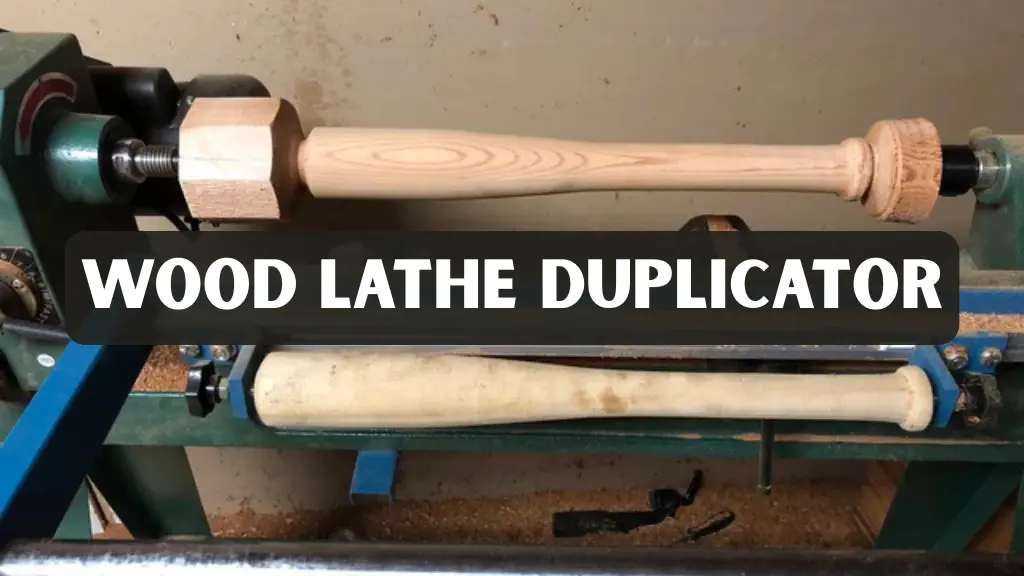Woodturning has always been one of the most respected woodworking crafts. The transformation of raw timber into elegant furniture parts or decorative designs represents both artistry and skill. Yet, one challenge consistently frustrates beginners and professionals alike: the ability to reproduce identical pieces with accuracy. If you have ever tried to carve a matching set of table legs or chair spindles by hand, you know just how difficult it can be to achieve true symmetry. This is precisely where the wood lathe duplicator proves its value.
By attaching a duplicator to a standard lathe, a craftsman can copy an existing template, pattern, or master piece with remarkable precision. The tool guides the cutting blade or router to follow the contours of the model, shaping the new piece into an almost exact replica. The result is consistent production, reduced waste, and greater efficiency, which benefits everyone from hobbyists to large furniture shops. In this detailed guide, we will explore how duplicators work, their types, advantages, buying considerations, maintenance practices, and even real-world examples of how they impact production.
What is a Wood Lathe Duplicator?
At its core, a wood lathe duplicator is a mechanical tracing device. It is an attachment that mounts onto a lathe and allows the operator to reproduce the form of a model piece. The duplicator has two primary components: a stylus or follower that traces the shape of the original, and a cutting tool that mirrors those movements on a blank workpiece. This means the woodworker no longer needs to rely solely on manual dexterity. Instead, the duplicator ensures that every detail of the master piece is reflected in the copy.
This makes the tool invaluable for anyone working on projects that require repetition and uniformity. A furniture maker producing dozens of chair spindles, for instance, cannot afford to have each one slightly different in shape. Similarly, a restorer repairing a set of antique railings must ensure the new parts match the originals perfectly. In such cases, the duplicator becomes more than a convenience; it is a necessity.
Why Every Workshop Benefits from a Duplicator
The appeal of a duplicator extends well beyond its mechanical function. One of its strongest advantages is the ability to produce precise results with far less effort compared to traditional turning. A craftsman who might otherwise spend thirty minutes carefully shaping a spindle by hand can complete the same piece in a fraction of the time. This efficiency allows for more completed projects and greater productivity in both hobbyist and professional workshops.
Consistency is another major benefit. While even the most skilled woodturner has a margin of error, a duplicator ensures that each part is identical. For projects requiring multiple matching components, such as a set of twenty chair legs, the tool removes subtle variations that would otherwise be noticeable. This reliability is especially valuable when uniformity is essential to the final product’s quality.
The duplicator also provides an advantage for beginners. Woodturning can take years of practice to master, particularly when it comes to duplicating complex shapes by hand. With this tool, even those with limited experience can achieve results that closely resemble professional craftsmanship. It lowers the learning curve, making woodworking more accessible and enjoyable for hobbyists while still supporting the needs of skilled artisans.
In addition, using a duplicator helps reduce material waste. Mistakes in freehand turning often result in discarding valuable wood, especially costly hardwoods. By guiding the cutting process with precision, a duplicator minimizes errors, conserving resources and lowering costs over time. For professionals working with premium materials, this advantage translates into significant financial savings alongside improved efficiency.
How a Lathe Duplicator Works
The operation of a duplicator is surprisingly straightforward. The first step is mounting the blank piece of wood securely on the lathe. This ensures stability and prevents unwanted movement during the cutting process. Once the blank is in place, the original model or template is fixed parallel to it, acting as the reference piece for duplication.
The operator then positions the stylus so it can run along the contours of the master piece. As the stylus traces the shape, the cutting tool mirrors its movement across the blank wood. This synchronous action is what creates the replica. The result is a new piece that matches the model in dimension and form. Depending on the design, light sanding and finishing may be needed to refine the final look, but the bulk of the shaping is already completed by the duplicator.
The choice of cutting method varies by model. Some duplicators use a simple cutting blade, while others are equipped with routers or even angle grinders. Router-based systems are especially popular because of their ability to handle hardwoods with cleaner cuts, though they require careful setup and adjustment.
Types of Lathe Duplicators
Duplicators come in several varieties, each offering unique advantages. A wood lathe duplicator can be found in different forms depending on the needs of the craftsman. Manual duplicators represent the simplest option. Operated entirely by hand, these systems rely on the woodworker to guide the stylus and cutter along the template. They are cost-effective, easy to install, and perfectly adequate for small workshops or hobby use.
Router-based duplicators are more advanced. By incorporating a mounted router as the cutting tool, they deliver cleaner results and greater versatility, especially when working with tougher woods. They are a common choice for professional woodworkers who require both speed and precision.
Angle grinder duplicators, often built as DIY projects, are powerful and fast. While they may not offer the fine precision of router systems, they are popular among hobbyists who enjoy building their own tools and experimenting with creative solutions.
At the highest level are CNC-controlled duplicators. These are computer-operated systems capable of producing flawless results with minimal human input. Although they are costly, they are indispensable for large-scale production where accuracy and speed are essential.
Advantages Beyond Precision
The duplicator is not just about accuracy. Its broader advantages make it an invaluable addition to many workshops. One of the most notable benefits is time savings. A craftsman who once struggled to keep up with customer demand can double or even triple output with the use of a duplicator. This allows for increased production without compromising quality.
Equally important is the professional finish that comes with consistent shaping. In furniture production, symmetry is vital to the overall appearance of the final product. A set of stair balusters that vary even slightly will appear uneven, reducing the perceived quality of the work. With a duplicator, every part is identical, creating a polished, professional look.
The duplicator also makes woodworking more accessible. Beginners who might feel intimidated by the complexity of hand-turning find that the duplicator removes much of the difficulty. This accessibility encourages more people to pursue woodworking as a hobby or profession, enriching the craft community.
Cost efficiency is another benefit that should not be overlooked. By reducing mistakes and wasted material, duplicators help woodworkers save money on supplies. In addition, the increased output they enable allows professionals to take on more orders and generate higher income.
Buying Guide Choosing the Right Duplicator
When it comes to selecting a wood lathe duplicator, compatibility is the first factor to consider. Not every duplicator fits every lathe, so it is essential to ensure the attachment is designed for your specific model. The type of cutting tool used is also significant. Router-based models may be more expensive, but they are ideal for hardwoods and offer a cleaner finish compared to blade-only systems.
Durability should also be a priority. A duplicator made from steel or aluminum will last much longer and provide more consistent results than one constructed from lightweight materials. Ease of installation is equally important, as some duplicators require professional setup while others are ready to use almost immediately.
Budget plays a central role in decision-making. Manual models may be found for under two hundred dollars, while advanced CNC duplicators can cost thousands. Balancing your needs with your budget ensures you make the right investment. Brand reputation is the final consideration. Choosing a trusted manufacturer with strong reviews ensures reliability and ongoing support. For additional buying insights, resources such as Popular Woodworking Magazine remain valuable guides for woodworkers.
DIY Wood Lathe
Many woodworkers enjoy the challenge of building their own duplicators. A typical homemade model involves creating a sturdy frame, attaching a stylus, and integrating a cutting tool such as a router or angle grinder. Rails are often added to ensure smooth, consistent movement.
The appeal of a DIY duplicator lies in its affordability and customization. Hobbyists can design a system tailored to their specific needs, adjusting size and function as required. However, while DIY duplicators are perfectly suitable for personal projects, they may lack the precision and durability required for professional use.
Real-World Applications
Duplicators serve countless purposes in woodworking. In furniture making, they are indispensable for producing legs, spindles, and bedposts that must all match perfectly. In architectural carpentry, they are used to create uniform railing posts and stair balusters. Restoration work also benefits from duplicators, as they allow craftsmen to replace missing or damaged parts of antiques with accurate replicas. Even artists and designers rely on duplicators when creating custom decorative pieces that need to be produced in multiples.
Maintenance for Longevity
Like any tool, a duplicator performs best when well maintained. Regular cleaning after each use prevents sawdust from clogging moving parts. Lubricating rails and joints keeps movement smooth, reducing wear over time. Cutting tools must be inspected often, as dull blades produce rough finishes and require more effort to correct. Alignment is another factor to check regularly. If the stylus and cutter are not properly aligned, the accuracy of duplication will be compromised. Finally, storing the duplicator in a dry environment helps prevent rust and extends its lifespan.
Case Study Workshop Efficiency with a Duplicator
A family-owned woodworking shop in North Carolina once relied on manual turning for their custom furniture. On average, a skilled craftsman produced just two spindles per hour, and even then, minor variations were common. After investing in a router-based duplicator, output increased to six spindles per hour, each one identical to the next. Clients immediately noticed the consistency, and the business grew as new orders flowed in. Within one year, revenue increased by a quarter. This case illustrates how a duplicator is not only a practical tool but also a profitable investment.
Common Mistakes to Avoid
Although duplicators simplify the process, certain mistakes can reduce their effectiveness. Failing to secure the workpiece properly can cause dangerous movement during turning. Using dull cutters leads to rough finishes that require excessive sanding. Neglecting safety equipment such as goggles and masks exposes the operator to unnecessary risk. Finally, attempting to duplicate without a proper template undermines the entire purpose of the tool, as the copy will lack the precision of a guided design.
Conclusion
A wood lathe duplicator offers far more than just mechanical assistance. It represents the meeting point between traditional craftsmanship and modern efficiency. For beginners, it opens the door to professional-quality results without years of training. For professionals, it increases production speed, enhances accuracy, and reduces waste.
Whether you choose to build a DIY model, invest in a manual attachment, or adopt a high-end CNC system, the duplicator will quickly become one of the most valuable tools in your workshop. By maintaining it properly, selecting the right model, and using it with care, you can ensure that your woodturning projects consistently reach the highest standards of quality. For anyone passionate about woodworking, the duplicator is not merely an accessory but a key to unlocking new possibilities in precision and design.
FAQs
What size duplicator should I buy?
The correct size depends on your lathe. Always check the swing and bed length to ensure compatibility.
Can beginners use a duplicator?
Yes. In fact, duplicators are particularly helpful for beginners because they eliminate much of the difficulty involved in achieving symmetry by hand.
Are DIY duplicators effective?
They are effective for hobby projects. However, professionals who require flawless precision may be better served by a commercial model.
Do duplicators work on all types of wood?
Yes, though hardwoods require more powerful cutting tools such as router-based systems to achieve clean results.
How much do duplicators cost?
Manual versions may cost under two hundred dollars, while CNC systems can reach several thousand depending on complexity and features.




